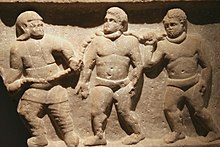Saylor.org's Ancient Civilizations of the World/Slavery
The Romans needed a large labor force to engineer their massive empire, and they got it through the institution of slavery. Unlike in the antebellum south of the United States, slavery in the Roman world was not entirely based on racial determinants or skin color. Romans acquired most of their slaves through military conquest, thus slaves in the empire were of diverse racial background: Celts, Germans, Thracians, Carthaginians, Greeks, even fellow Latins on the Italian peninsula. While taking defeated soldiers into slavery made warfare make more economic sense than merely imprisoning or executing them, it was not the only means by which a slave was 'created' in the Roman world. Free parents had the right to sell their children into slavery, as all children born to slaves were made slaves as well. As well, slavery was a fate met by children abandoned at birth and insolvent debtors.

However, a slave could receive manimissimo, and become a libertus, or freedman. Manimissimo could be extended for a number of reasons, ranging from friendship and respect between the master and slave to the slave saving his money to purchase his freedom (the latter being a very rare event). Although a freedman did not receive all the benefits of full Roman citizenship, a freedman could still very well live a successful life following manimissimo. Furthermore, the children of freed slaves would receive full Roman citizenship upon birth.
Slaves mainly worked the menial, hard-labor jobs that allowed the empire to flourish, including but not limited to cleaning, mining, farming, trash collecting and prostitution. Because so much of their civilized society depended on the work of slaves (and therefore the contentment of the slaves), masters lived in fear of slave uprisings or general malicious disobedience (such as slave cooks poisoning meals). For this reason, masters often held the possibility of freedom as a reward for good behavior from their slaves. Good slaves were made examples of with freedom, as bad slaves were made examples of with severe punishments.
The most famous Roman slave uprising was led by Spartacus. Spartacus amassed a force of some 70,000 slaves to revolt against the Romans. Although historians argue about what Spartacus' ultimate goals were. Some turn to Plutarch's account which says that Spartacus intended to return to Cisalpine Gaul and disperse the slaves back to their original homes. Others wonder then why Spartacus turned south back down into the Italian peninsula if he was trying to escape. Instead, these historians see this as evidence that the slave revolt was intending to march on Rome or, at the very least, plunder and pillage Italian villages. Either way, Spartacus was defeated in battle in 71 BCE and some 6,000 revolting slaves were captured and executed on crucifixes that lined the Appian Way.